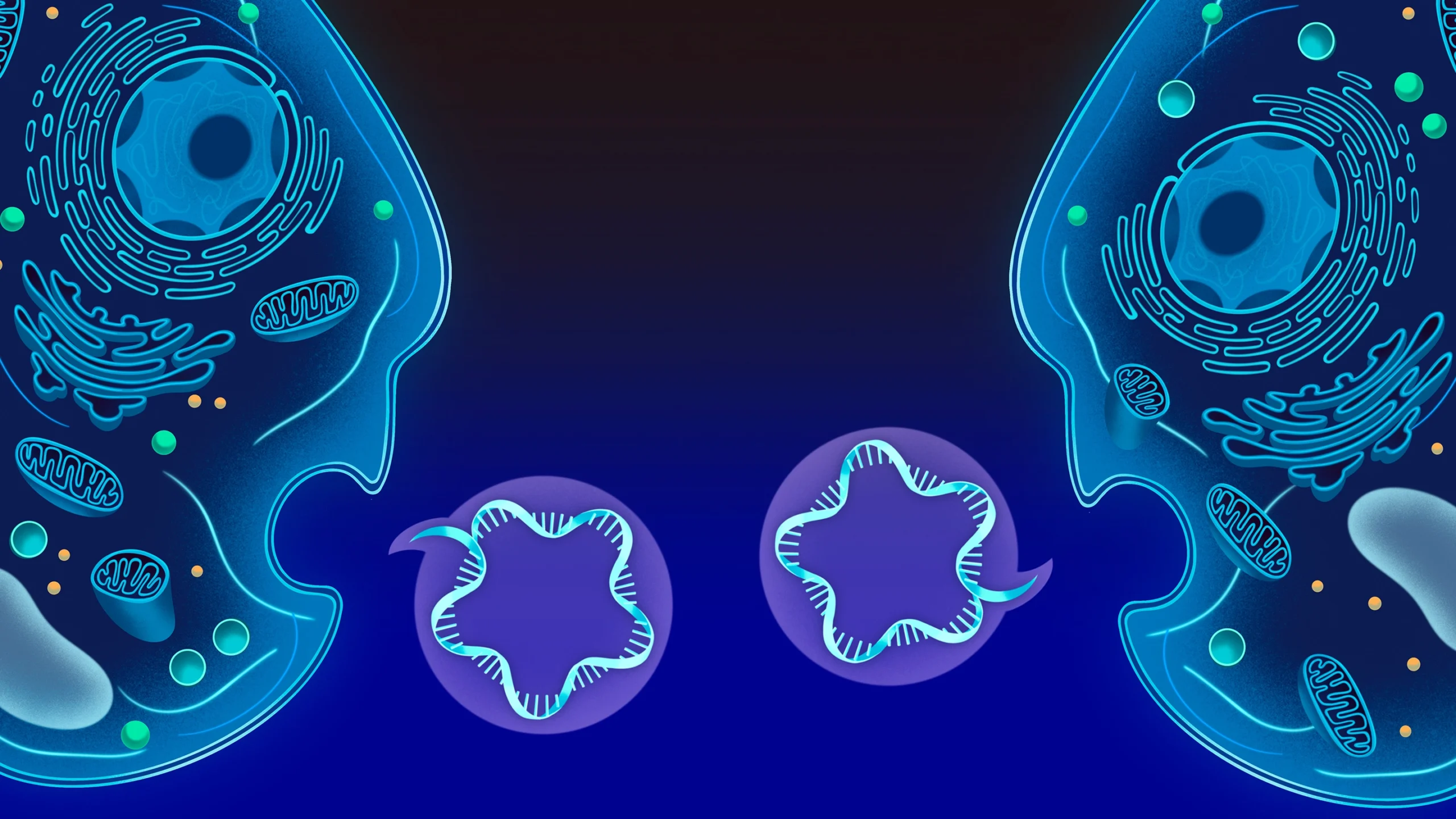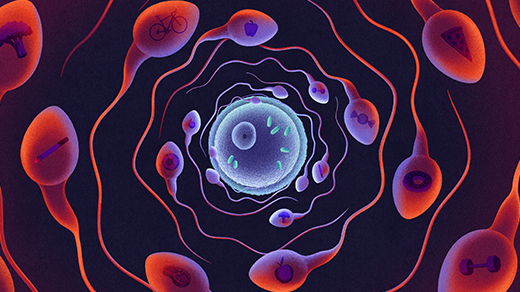Cells Across the Tree of Life Exchange ‘Text Messages’ Using RNA

Cells across the tree of life can swap short-lived messages encoded by RNA — missives that resemble a quick text rather than a formal memo on letterhead.
Nash Weerasekera for Quanta Magazine
Introduction
For a molecule of RNA, the world is a dangerous place. Unlike DNA, which can persist for millions of years in its remarkably stable, double-stranded form, RNA isn’t built to last — not even within the cell that made it. Unless it’s protectively tethered to a larger molecule, RNA can degrade in minutes or less. And outside a cell? Forget about it. Voracious, RNA-destroying enzymes are everywhere, secreted by all forms of life as a defense against viruses that spell out their genetic identity in RNA code.
There is one way RNA can survive outside a cell unscathed: in a tiny, protective bubble. For decades, researchers have noticed cells releasing these bubbles of cell membrane, called extracellular vesicles (EVs), packed with degraded RNA, proteins and other molecules. But these sacs were considered little more than trash bags that whisk broken-down molecular junk out of a cell during routine decluttering.
Then, in the early 2000s, experiments led by Hadi Valadi, a molecular biologist at the University of Gothenburg, revealed that the RNA inside some EVs didn’t look like trash. The cocktail of RNA sequences was considerably different from those found inside the cell, and these sequences were intact and functional. When Valadi’s team exposed human cells to EVs from mouse cells, they were shocked to observe the human cells take in the RNA messages and “read” them to create functional proteins they otherwise wouldn’t have been able to make.
Valadi concluded that cells were packaging strands of RNA into the vesicles specifically to communicate with one another. “If I have been outside and see that it’s raining,” he said, “I can tell you: If you go out, take an umbrella with you.” In a similar way, he suggested, a cell could warn its neighbors about exposure to a pathogen or noxious chemical before they encountered the danger themselves.
Since then, a wealth of evidence has emerged supporting this theory, enabled by improvements in sequencing technology that allow scientists to detect and decode increasingly small RNA segments. Since Valadi published his experiments, other researchers have also seen EVs filled with complex RNA combinations. These RNA sequences can contain detailed information about the cell that authored them and trigger specific effects in recipient cells. The findings have led some researchers to suggest that RNA may be a molecular lingua franca that transcends traditional taxonomic boundaries and can therefore encode messages that remain intelligible across the tree of life.
In 2024, new studies have exposed additional layers of this story, showing, for example, that along with bacteria and eukaryotic cells, archaea also exchange vesicle-bound RNA, which confirms that the phenomenon is universal to all three domains of life. Another study has expanded our understanding of cross-kingdom cellular communication by showing that plants and infecting fungi can use packets of havoc-wreaking RNA as a form of coevolutionary information warfare: An enemy cell reads the RNA and builds self-harming proteins with its own molecular machinery.
“I’ve been in awe of what RNA can do,” said Amy Buck, an RNA biologist at the University of Edinburgh who was not involved with the new research. For her, understanding RNA as a means of communication “goes beyond appreciating the sophistication and the dynamic nature of RNA within the cell.” Transmitting information beyond the cell may be one of its innate roles.
Time-Sensitive Delivery
The microbiologist Susanne Erdmann studies viral infections in Haloferax volcanii, a single-celled organism that thrives in unbelievably salty environments such as the Dead Sea or the Great Salt Lake. Single-celled bacteria are known to exchange EVs widely, but H. volcanii is not a bacterium — it’s an archaean, a member of the third evolutionary branch of life, which features cells built differently from bacteria or eukaryotes like us.
Because EVs are the same size and density as the virus particles Erdmann’s team studies at the Max Planck Institute for Marine Microbiology in Germany, they “always pop up when you isolate and purify viruses,” she said. Eventually, her group got curious and decided to peek at what’s inside.

The microbiologist Susanne Erdmann recently found archaea enclosing RNA in cellular bubbles and dispatching it into the environment. Her discovery extended our knowledge of this messaging ability to all three domains of life.
Alina Esken/Max Planck Institute for Marine Microbiology
“I was expecting DNA,” Erdmann recalled, following reports that other archaeal species pack DNA into EVs. Instead, her lab found a whole smorgasbord of RNA — specifically noncoding RNAs, mysterious stretches of nucleotides with no known function in archaea. These noncoding RNA sequences were much more abundant in the EVs than in the archaeal cells themselves. “It was the first time that we found RNA in EVs in archaea,” she said.
Erdmann wondered if there was a purpose to the archaean EVs. A cell can spontaneously make vesicles when its membrane pinches in on itself to form a little bubble that then detaches. However, other mechanisms involve more active and deliberate processes, similar to the ones that move molecules around inside the cell. Erdmann’s group identified an archaeal protein that was essential for producing RNA-containing EVs.
That suggested to her that the RNA wasn’t ending up in the EVs by chance, and that the process wasn’t just waste disposal. “It’s very likely that [archaea] use them for cell-to-cell communication,” she said. “Why else would you invest so much energy in throwing out random RNA in vesicles?”
Erdmann isn’t sure why the Haloferax microbes pack their vesicles with RNA while other archaeal species prefer DNA. But she suspects it has to do with how time sensitive the molecular message is. “RNA is a different language than DNA,” she said, and it serves a fundamentally different purpose both inside and outside cells.
Mark Belan for Quanta Magazine
An organism’s DNA should be stable and relatively unchanging over the course of its life. It may pick up spontaneous mutations or even extra genes, but it takes generations of natural selection for temporary changes in DNA sequences to take hold in a population. RNA, on the other hand, is constantly in flux, responding to dynamic conditions inside and outside the cell. RNA signals don’t last long, but they don’t need to, since they can so quickly become irrelevant.
As a message, RNA is transient. This is a feature, not a bug: It can have only short-term effects on other cells before it degrades. And since the RNA inside a cell is constantly changing, “the message that you can send to your neighboring cell” can also change very quickly, Erdmann said. In that sense, it’s more like a quick text message or email meant to communicate timely information than, say, runes etched in stone or a formal memo on letterhead.
While it seems that neighboring archaea are taking up and internalizing EVs from their fellow cells, it’s not clear yet whether the messages affect them. Erdmann is also already wondering what happens to these vesicles in the wild, where many different organisms could be within earshot of the messages they carry.
“How many other different organisms in the same environment could take up this message?” she asked. “And do they just eat it and use the RNA as food, or do they actually detect the signal?”
While that may still be a mystery for Haloferax, other researchers have demonstrated that cells across species, kingdoms and even domains of life can send and receive remarkably pointed molecular missives.
Biological Cross Talk
Although RNA is short-lived, it has revealed itself to be a shape-shifting molecular marvel. It’s best known for helping cells produce new proteins by copying DNA instructions (as messenger RNA, or mRNA) and delivering them to the ribosome for construction. However, its flexible backbone lets RNA fold into a number of shapes that can impact cell biology. It can act as an enzyme to accelerate chemical reactions within cells. It can bind to DNA to activate or silence the expression of genes. And competing strands of RNA can tangle up mRNA instructions in a process called RNA interference that prevents the production of new proteins.
As researchers increasingly appreciate the ways RNA changes cell activity, they’ve studied strategies to use this mutable little molecule as an experimental tool, a disease treatment, and even the basis for the Covid-19 mRNA vaccine. All of these applications require transferring RNA into cells, but it seems that evolution has beaten us to it: EVs transmit RNA even to cells that may not want to get the message.
About 10 years ago, the molecular geneticist Hailing Jin and her lab at the University of California, Riverside discovered that two organisms from different kingdoms — a plant and a fungus — exchange RNA as a form of warfare. Jin was studying Botrytis cinerea, a fuzzy gray mold that ravages crops such as strawberries and tomatoes, when she saw it swap RNA with the plant Arabidopsis (thale-cress) during infection. The Botrytis fungus delivered RNA that interfered with the plant’s ability to fight the infection. Later work showed that the plant cells could respond with their own volley of RNA that damaged the fungus.
In this “coevolutionary arms race,” as Jin described it, both organisms used EVs as vehicles for these delicate but damaging RNA messages. Previously, scientists interested in host-pathogen dynamics mainly focused on proteins and metabolites, Jin said, because those molecules can be easier to study. But it makes sense for organisms to have multiple ways of resisting environmental challenges, she said, including using RNA to interact with distant evolutionary relatives.
Over the last decade, more scientists have discovered examples of cross-kingdom RNA exchange as an offensive strategy during infection. Parasitic worms living in mouse intestines release RNA in EVs that shut down the host’s defensive immune proteins. Bacteria can shoot messages to human cells that tamp down antibacterial immune responses. The fungus Candida albicans has even learned to twist a message from human EVs to its own advantage: It uses human RNA to promote its own growth.
Cross-kingdom correspondence isn’t always hate mail. These interactions have also been seen in friendly (or neutral) relationships, Jin said. For example, bacteria that live symbiotically in the roots of legumes send RNA messages to promote nodulation — the growth of little bumps where the bacteria live and fix nitrogen for the plant.
How can RNA from one branch of the tree of life be understood by organisms on another? It’s a common language, Buck said. RNA has most likely been around since the very beginning of life. While organisms have evolved and diversified, their RNA-reading machinery has largely stayed the same. “RNA already has a meaning in every cell,” Buck said. “And it’s a pretty simple code.”
So simple, in fact, that a recipient cell can open and interpret the message before realizing it could be dangerous, the way we might instinctively click a link in an email before noticing the sender’s suspicious address. Indeed, earlier this year, Jin’s lab showed that Arabidopsis plant cells can send seemingly innocuous RNA instructions that have a surprise impact on an enemy fungus. In experiments, Jin’s team saw the Botrytis fungus read the invading mRNA along with its own molecules and unwittingly create proteins that damaged its infectious abilities.
It’s almost as if the plants were creating a “pseudo-virus,” Jin said — little packets of RNA that infect a cell and then use that cell’s machinery to churn out proteins.
“This is a pretty powerful mechanism,” she said. “One mRNA can be translated into many, many copies of proteins. … It’s much more effective than transporting the protein itself.”
To her knowledge, Jin said, this is the first time she’s seen evidence of organisms across kingdoms exchanging mRNA messages and reading them into proteins. But she thinks it’s likely to be seen in lots of other systems, once people start looking for it.
The field feels young, Buck said, which is exciting. There’s still a lot to learn: for example, whether the other molecules packaged in EVs help deliver the RNA message. “It’s a fun challenge to unravel all of that,” she said. “We should be inspired with how incredibly powerful and dynamic RNA is, and how we’re still discovering all the ways that it shapes and regulates life.”



